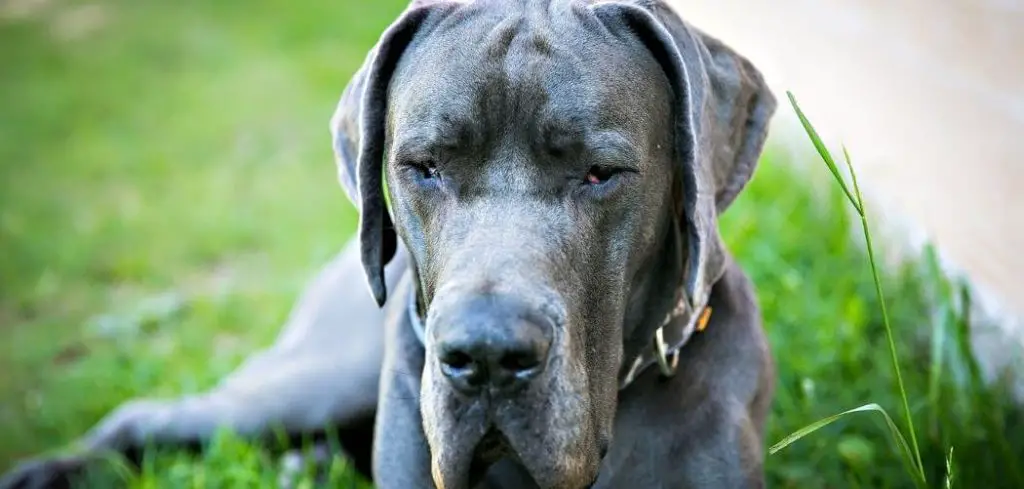When an older dog begins drinking large amounts of water and panting heavily, it can be a sign of something more than just aging. These symptoms often point to underlying health concerns that need attention.
We outline the common causes of excessive thirst and panting in an old dog, what you can do at home, and when to seek veterinary help.
Old Dog Excessive Thirst and Panting — Why It Happens
Excessive thirst and panting in older dogs are often linked to age-related health conditions. Problems such as kidney disease, diabetes, Cushing’s disease, heart failure, and heat-related stress can all play a role.
Certain medications may also increase thirst and contribute to panting. Because these issues are common in senior dogs, noticing both symptoms together should not be ignored.

Old Dog Excessive Thirst and Panting: Common Causes
Kidney Disease
Kidney disease is a leading cause of excessive thirst in older dogs. As the kidneys lose their ability to filter waste, the body compensates by pulling in more water.
Panting often follows because toxins build up in the bloodstream, making the dog feel weak and uncomfortable.
Dogs with kidney issues may urinate more frequently, lose weight, or show signs of lethargy. Over time, kidney disease becomes progressively worse, making early recognition crucial.
Read more: Old Dog Panting Excessively at Night (Here’s what it means)
Diabetes
Diabetes causes the body to struggle with regulating blood sugar. Excess glucose spills into the urine, dragging water with it and leading to dehydration. To compensate, the dog drinks excessively.
Panting often develops when diabetes remains uncontrolled. The body shifts to burning fat for energy, which produces ketones, a condition that can cause weakness, nausea, and heavy breathing. Without treatment, this can become life-threatening.
Cushing’s Disease
Cushing’s disease occurs when a dog produces too much cortisol. This hormone imbalance causes increased thirst, excessive urination, and a ravenous appetite. Panting is also common because cortisol affects metabolism and circulation.
Owners may notice a pot-bellied appearance, thinning fur, or muscle weakness in dogs with Cushing’s. The condition is treatable but requires veterinary testing and ongoing management.
Heart Disease
Heart failure is another serious cause of panting and excessive thirst in older dogs. When the heart struggles to pump blood efficiently, the body does not receive enough oxygen. This leads to heavy breathing and panting as the dog tries to compensate.
Fluid buildup in the lungs and abdomen may also occur. Dogs often appear restless, cough frequently, and may drink more in an attempt to ease discomfort. Left untreated, heart failure can rapidly progress.
Heat Stress
Older dogs are more vulnerable to heat than younger ones. Even mild temperatures can cause overheating, especially in breeds with thick coats or short snouts.
Panting is the body’s way of cooling down, but when combined with excessive thirst, it signals that the dog is struggling.
Heat stress can escalate into heatstroke, a life-threatening condition that requires immediate action. Senior dogs should always have access to shade and fresh water.
Medication Side Effects
Some medications prescribed to senior dogs can cause side effects such as increased thirst and panting. Steroids like prednisone, for example, are commonly used for inflammation but often lead to these symptoms.
If changes in drinking or breathing appear soon after starting a new medication, it is important to inform the veterinarian. Adjustments or alternatives may be available.
What to Do If Your Old Dog Is Excessively Thirsty and Panting
If an older dog suddenly drinks more and pants heavily, owners should first monitor the situation carefully. Keep track of how much water the dog consumes each day and when panting episodes occur. This information is very helpful for veterinarians.
Ensure the dog has constant access to fresh water, especially in warm weather. Do not restrict water, even if urination increases, as dehydration can quickly worsen health problems.
Providing a cool, comfortable resting place is important. Fans, air conditioning, and shaded areas outdoors can all help keep body temperature down.
At mealtimes, offering balanced, nutritious food supports overall health. Avoid salty treats or foods that may worsen thirst. If the dog seems weak or reluctant to eat, softer or easily digestible options may encourage better intake.
Finally, schedule a veterinary exam promptly. Bloodwork, urinalysis, and imaging may be needed to determine the cause. Acting early can make treatment more effective and improve the dog’s quality of life.
When to Call or Visit Your Vet
Immediate veterinary care is needed if an old dog is panting excessively and seems unable to rest. Signs such as labored breathing, collapse, or refusal to drink water should never be ignored.
Other warning signs include sudden weight loss, persistent vomiting, diarrhea, or a pot-bellied abdomen. If the dog coughs frequently, appears restless at night, or shows rapid changes in behavior, urgent care is recommended.
Even if symptoms seem mild, any increase in thirst and panting that lasts more than a few days warrants an appointment. Early intervention is key to managing chronic illnesses.
Read more: Old Dog Panting and Drinking Lots of Water (Why it happens)
Key Takeaway
Excessive thirst and panting in older dogs should never be dismissed as simple aging. These signs often indicate underlying health conditions such as kidney disease, diabetes, Cushing’s disease, or heart failure.
Owners can help by monitoring water intake, ensuring comfort, and seeking veterinary advice quickly. With timely care, many senior dogs can continue to enjoy a comfortable and happy life despite these challenges.
